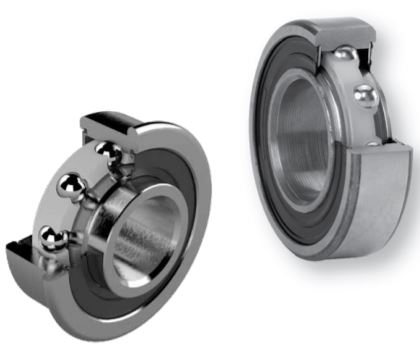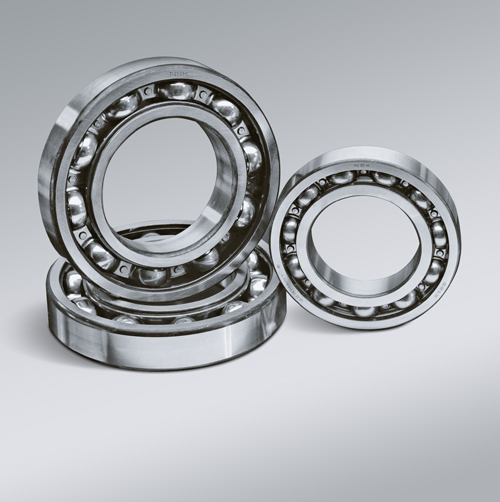What are the challenges and solutions for managing radial loads and axial loads in deep groove ball bearings?
Managing both radial loads and axial loads in deep groove ball bearings can present certain challenges. However, there are solutions available to address these challenges effectively. Here’s a detailed explanation of the challenges and solutions for managing radial loads and axial loads in deep groove ball bearings:
- Challenges:
- Increased contact pressure and localized stress on the raceways due to axial loads
- Potential ball skidding or sliding under high axial loads, leading to uneven wear
- Risk of ball and raceway deformation or brinelling under excessive axial loads
- Solutions:
- Proper Bearing Selection: Selecting deep groove ball bearings that are designed to handle both radial and axial loads is crucial. Bearings with higher axial load capacities, such as deep groove ball bearings with filling slots or angular contact ball bearings, may be suitable for applications with significant axial loads.
- Optimized Internal Clearance: The internal clearance of the bearing can be adjusted to accommodate the expected radial and axial loads. This ensures optimal load distribution and minimizes the risk of excessive stress concentrations. Manufacturers provide guidelines on the appropriate internal clearance for different load conditions.
- Bearing Preload: Preloading the bearings can help manage axial loads by applying a controlled amount of internal axial force. This ensures that the bearings maintain contact with the raceways and minimizes the risk of ball skidding or sliding. Preloading is commonly used in applications such as machine tools.
- Use of Thrust Bearings: In applications with high axial loads, incorporating thrust bearings in conjunction with deep groove ball bearings can help manage the axial component effectively. Thrust bearings are designed specifically to handle axial loads and can be used in combination with deep groove ball bearings to support both radial and axial loads.
- Design Considerations: Careful consideration of the application’s operating conditions, load magnitudes, and directions is essential. This includes analyzing the ratio of radial to axial loads, the presence of shock or impact loads, and any misalignment or angular loads that may affect bearing performance. By understanding the specific requirements, the bearing arrangement and selection can be optimized for improved load management.
Deep groove ball bearings are primarily designed to handle radial loads. When subjected to significant axial loads, they may experience increased stress and premature wear, potentially leading to bearing failure. The challenges in managing radial loads and axial loads include:
To effectively manage radial loads and axial loads in deep groove ball bearings, the following solutions can be implemented:
In summary, managing radial loads and axial loads in deep groove ball bearings requires careful consideration and appropriate solutions. Proper bearing selection, optimized internal clearance, bearing preload, the use of thrust bearings, and design considerations tailored to the application’s requirements are key steps in effectively managing both radial and axial loads. By implementing these solutions, the performance and longevity of deep groove ball bearings can be maximized, ensuring reliable operation under varying load conditions.
How does proper lubrication impact the performance and longevity of deep groove ball bearings?
Proper lubrication plays a crucial role in determining the performance and longevity of deep groove ball bearings. Here’s a detailed explanation of how proper lubrication impacts these aspects:
- Reduced Friction and Wear:
- Heat Dissipation:
- Corrosion and Contamination Protection:
- Noise and Vibration Reduction:
- Effective Load Distribution:
- Preservation of Bearing Integrity:
Lubrication creates a thin film of lubricant between the rolling elements and the raceway surfaces of the deep groove ball bearing. This film of lubricant reduces friction and minimizes metal-to-metal contact, resulting in lower wear and extending the bearing’s lifespan. Proper lubrication ensures that the lubricant film remains intact, preventing excessive friction, heat generation, and premature wear of the bearing components.
Deep groove ball bearings can generate heat during operation due to the sliding and rolling contact between the balls and the raceways. Adequate lubrication helps in dissipating this heat by carrying it away from the contact zone. Proper lubrication prevents the bearing from overheating, which can lead to accelerated wear, loss of dimensional stability, and even bearing failure.
Lubrication provides a protective barrier against corrosion and contamination. The lubricant helps to seal the bearing against external elements such as moisture, dust, dirt, and other contaminants that can degrade the bearing surfaces and compromise its performance. By preventing corrosion and contamination, proper lubrication extends the bearing’s service life and ensures reliable operation in challenging environments.
Insufficient or improper lubrication can result in increased noise and vibration levels in deep groove ball bearings. The lubricant acts as a cushioning medium, absorbing shocks and reducing the transmission of vibrations. Proper lubrication minimizes the generation of noise and vibrations, resulting in smoother and quieter operation of the bearing.
Proper lubrication ensures effective load distribution within the deep groove ball bearing. The lubricant film helps distribute the applied loads evenly across the rolling elements and raceways, minimizing stress concentrations and preventing premature fatigue or failure of the bearing. This promotes the bearing’s load-carrying capacity and enhances its overall performance and reliability.
Adequate lubrication helps preserve the overall integrity of deep groove ball bearings. It reduces the risk of surface damage, pitting, and scoring, which can lead to accelerated wear and premature failure. Proper lubrication also prevents the formation of rust and corrosion, preserving the structural integrity of the bearing components and ensuring their long-term functionality.
In summary, proper lubrication of deep groove ball bearings is essential for reducing friction and wear, dissipating heat, protecting against corrosion and contamination, minimizing noise and vibrations, facilitating effective load distribution, and preserving the overall integrity of the bearing. By ensuring proper lubrication, the performance and longevity of deep groove ball bearings can be significantly enhanced, resulting in reliable operation and extended service life.
How do temperature variations and environmental conditions impact the performance of deep groove ball bearings?
Temperature variations and environmental conditions can have a significant impact on the performance of deep groove ball bearings. These factors can affect the bearing’s lubrication, material properties, dimensional stability, and overall operating characteristics. Here’s a detailed explanation of how temperature variations and environmental conditions impact the performance of deep groove ball bearings:
- Lubrication:
- Material Properties:
- Dimensional Stability:
- Operating Characteristics:
- Environmental Effects:
Temperature variations can influence the viscosity and lubricating properties of the bearing grease or oil. High temperatures can cause lubricants to thin out, reducing their ability to form a protective film between the rolling elements and raceways. This can lead to increased friction, wear, and heat generation, potentially resulting in premature bearing failure. Conversely, extremely low temperatures can cause lubricants to thicken, impeding their flow and impairing the bearing’s ability to maintain proper lubrication. It is crucial to select lubricants suitable for the expected temperature range to ensure optimal lubrication and minimize the negative effects of temperature variations on bearing performance.
Temperature variations can affect the material properties of the bearing components. High temperatures can cause thermal expansion, leading to dimensional changes in the bearing’s inner and outer rings, as well as the rolling elements. This can result in increased radial internal clearance and potential misalignment, affecting the bearing’s running accuracy and performance. Additionally, high temperatures can accelerate the aging or degradation of bearing materials, reducing their strength and fatigue resistance. Extreme cold temperatures, on the other hand, can make materials more brittle, increasing the risk of fracture or damage under load. It is important to consider the expected temperature range and select bearing materials that can withstand the anticipated thermal conditions to ensure reliable and long-lasting performance.
Temperature variations can impact the dimensional stability of deep groove ball bearings. As temperatures change, the bearing components can expand or contract, affecting the internal clearance and fit of the bearing. This can lead to changes in running accuracy, noise levels, and the ability to maintain proper alignment within the application. In applications where precise positioning or running accuracy is critical, temperature variations must be taken into account to ensure the bearing maintains the required dimensional stability and performance under varying thermal conditions.
Temperature variations can affect the overall operating characteristics of deep groove ball bearings. High temperatures can increase the operating noise and vibration levels of the bearing, potentially impacting the comfort and performance of the machinery or equipment in which the bearing is installed. Temperature-induced expansion or contraction can also affect the bearing’s ability to handle axial or radial loads, potentially altering the load distribution and causing uneven wear or excessive loading on certain areas of the bearing. Understanding the operating characteristics of the bearing in relation to temperature variations is crucial for selecting the appropriate bearing type and size for the specific application.
Environmental conditions, such as dust, moisture, chemicals, or corrosive substances, can also impact the performance of deep groove ball bearings. Dust and dirt particles can infiltrate the bearing, leading to increased friction, wear, and potential damage to the rolling elements and raceways. Moisture or corrosive substances can cause rust or corrosion, compromising the bearing’s structural integrity and lubrication properties. It is important to consider the environmental conditions in which the bearing will operate and select appropriate sealing solutions or protective coatings to mitigate the effects of contaminants or corrosive elements.
In summary, temperature variations and environmental conditions can significantly impact the performance of deep groove ball bearings. By understanding the effects of temperature on lubrication, material properties, dimensional stability, and operating characteristics, appropriate measures can be taken to ensure optimal bearing performance and longevity. Considering the expected temperature range, selecting suitable materials, providing proper lubrication, addressing dimensional changes, and protecting against environmental factors are all important considerations when using deep groove ball bearings in different operating conditions.
editor by CX 2024-05-07




